Leaf Feeders
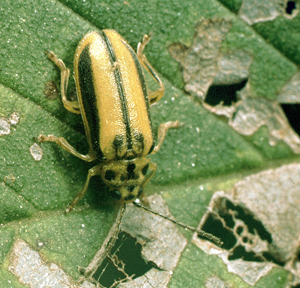
Clemson University - USDA Cooperative Extension Slide Series, Bugwood.org
Elm leaf beetles are 1/4 inch long yellow to olive green beetles with a dark stripe down each side of their wing covers. There is a row of four dark spots behind the head. Adults spend the winter in protected locations, sometimes in houses or other structures. The beetles chew small holes in newly developing leaves in the spring. Females lay clusters of 5 to 25 eggs on the underside of leaves. The insects feed on all elms but seem to prefer Siberian elm. The green to yellow worm-like larvae have a black head and two black stripes along the back and are up to 1/2 inch long. The larvae feed on the underside of the leaves, leaving the upper surface and veins intact. Elm leaf beetle larvae often move to the base of the tree in large numbers to pupate. There are two complete generations per year. For more information, see Entfact 400.

Lee Townsend, University of Kentucky
Japanese beetles can feed on about 300 species of plants ranging from roses to poison ivy but basswood is one of their favorites. They usually feed in groups, starting at the top of the tree and working downward, and prefer plants that are exposed to direct sunlight. A single beetle does not eat much; it is group feeding by many beetles that causes severe damage. Adults feed on the upper surface of foliage, chewing out tissue between the veins. This gives the leaf a characteristic skeletonized appearance. For more information, see Entfact 451.
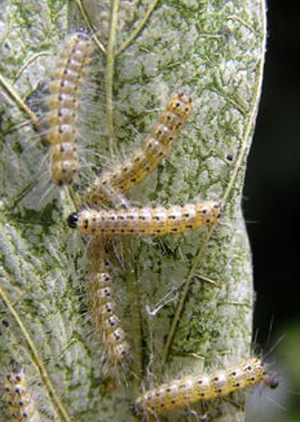
Milan Zubrik, Forest Research Institute - Slovakia, Bugwood.org
Fall webworms are small hairy white caterpillars that live communally in thin silken webs at the ends of branches. They may leave the tent to feed individually as they get larger. While the webbing is unsightly, feeding damage is usually limited to limbs around the tent. Large established trees are not seriously affected by small to moderate infestations. The larval stage feeds for 4 to 8 weeks and may be found on a variety of hardwoods. The first generation occurs in late May and early June, the second generation is usually larger and active from July through September. For more information, see Entfact 424.
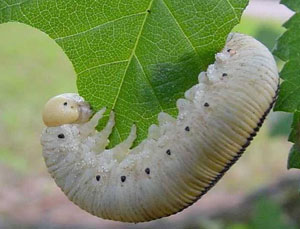
Herbert A. 'Joe' Pase III, Texas A&M Forest Service, Bugwood.org
Elm sawfly is the largest North American sawfly species. Adult wasps cut thin areas of bark on twigs in order to feed on sap. Larvae can defoliate trees when present in high enough numbers. The larvae are known for coiling around twigs while feeding or at rest. Larvae are green to yellow-green and reach two inches in length. Adults are sexually dimorphic, both are large and black but females have multiple yellow stripes on the abdomen. Males only have one and have large femurs. Adults may be seen in May-June.
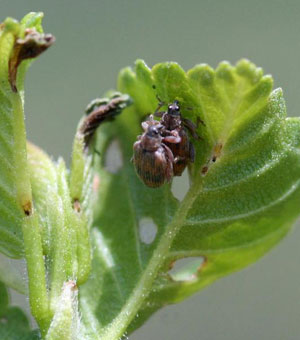
Whitney Cranshaw, Colorado State University, Bugwood.org
The European elm flea weevil is an invasive species that feeds on Asian varieties of elms in the landscape. Flea weevils are small, less than 1/8th inch long, and are capable of jumping great distances for their size. Adult weevils are a black and reddish-brown color and leave behind characteristic shot-hole feeding damage in leaves. Larvae are legless grubs that create blotch-like leaf-mines. Overwintering adults emerge in May-June to feed and lay eggs. Larval damage occurs over the summer. New adults emerge in August and will overwinter.
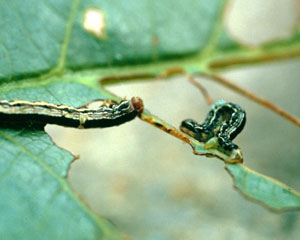
A. Steven Munson, USDA Forest Service, Bugwood.org
Fall cankerworm is a looper caterpillar that can vary from light green with yellow stripes to green with a dark stripe down the back. Overwintering masses of about 100 eggs hatch in later April or early May; small caterpillars chew small holes in young leaves at branch tips. Larger loopers leave only the midrib and major veins. Fall cankerworms are about an inch long when full grown. Mature larvae descend from trees on silk threads to pupate in the soil. They emerge as adults during periods of freezing temperatures to mate and lay eggs on host plants. There is one generation each year.
Sap Feeders
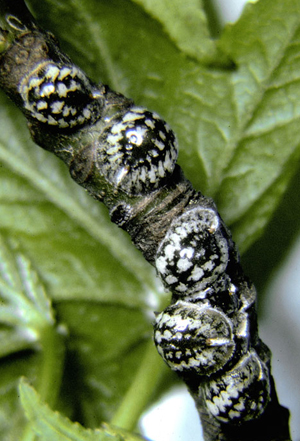
Raymond Gill, California Department of Food and Agriculture, Bugwood.org
Calico scale is a white and dark brown soft scale about 1/4 inch in diameter. It produces a large amount of honeydew in the spring so twigs, branches, and leaves may be covered with sooty mold. This scale can severely weaken trees, making them more vulnerable to drought and other stresses. Egg hatch occurs in May and the crawlers move to leaves to feed for the summer. Nymphs move back to bark for the winter.
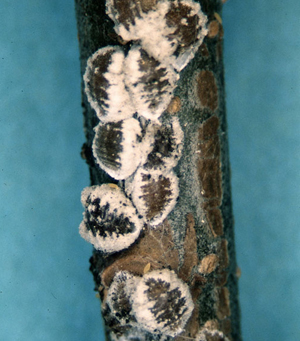
Whitney Cranshaw, Colorado State University, Bugwood.org
European elm scale is a soft scale that spends the winter as an immature stage in bark cracks. Crawlers begin to appear in June and move to the undersides of leaves where they settle and feed for the summer. They will move back to bark before leaves drop in the fall. There is one generation each year. Heavy infestations can cause stunted, chlorotic foliage, premature leaf drop, and occasionally branch die-back. These scales produce large amounts of sticky honeydew; infested branches and leaves can become black with sooty mold growth.
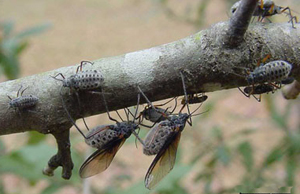
Herbert A. 'Joe' Pase III, Texas A&M Forest Service, Bugwood.org
Giant bark aphid is the largest aphid in North America. This sap feeder can live on several tree species. Winged forms disperse from tree to tree. Wingless aphids occur in large colonies. These aphids produce a large amount of sticky liquid waste, honeydew, which drips onto objects below. Feeding by large numbers of these aphids can damage or kill small twigs. They are eaten by lady beetles and other predators.
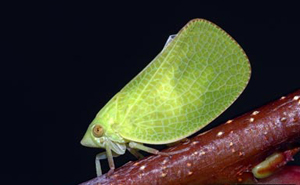
Susan Ellis, Bugwood.org
Leafhoppers are small, light green, active insects that live on the underside of the leaves. They use sucking mouthparts to feed on plant sap. Usually large numbers are present by the time the injury is obvious. Heavily damaged leaves may drop early but this insect usually does not cause serious problems.
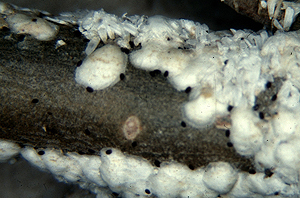
Whitney Cranshaw, Colorado State University, Bugwood.org
Scurfy scale is an armored scale that can infest several hardwoods. Adult females have 0.1 inch diameter dirty white, flat pear-shaped bodies; males are smaller and narrower. There can be two generations every year with first generation crawlers active in mid- to late spring. Infestations tend to occur on shady sides of trees and give the bark a flaky appearance.
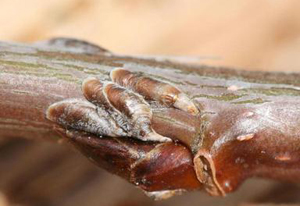
Whitney Cranshaw, Colorado State University, Bugwood.org
Oystershell scales are about 1/10 inch long and resemble crusty accumulations of oyster shells on the bark. Their drab, bark-like appearance makes them easy to overlook, even on close inspection. Heavy infestations can kill twigs or branches. This scale overwinters in the egg stage under the waxy covering of the female. The eggs hatch and the crawlers are active from late May to early June.
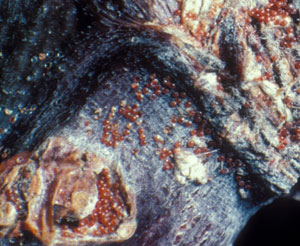
University of Georgia Plant Pathology, University of Georgia, Bugwood.org
The European red mite female is brick red, while the male is a pale yellow-green. They are small and globular. Some individuals may "balloon" to new locations, creating new infestations. They can feed on many different species of plants and cause leaves to become pale and eventually bronze. There can be 6-8 generations per year depending on the weather and they overwinter as eggs that are laid in the bark and near buds (red spheres in image at left). For more information, see Entfact 205.
Borers
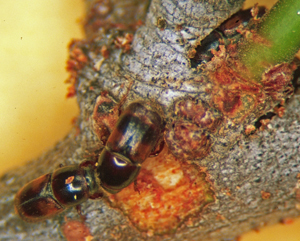
Whitney Cranshaw, Colorado State University, Bugwood.org
Native and European elm bark beetles attack weakened and dying limbs. They carry spores of Dutch elm disease which can kill trees.
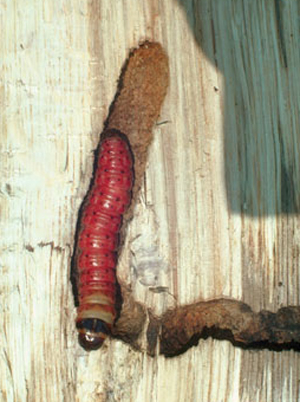
James Solomon, USDA Forest Service, Bugwood.org
Carpenterworms are reddish pink caterpillars that tunnel into the bark and wood of oaks, especially red oaks and a number of other hardwoods. Their damage causes unsightly scars on ornamental trees and degrades rough sawn lumber. Eggs are laid in bark crevices or under vines and lichens. Small larvae feed into the phloem and cambium but soon chew into the sapwood. Fine frass mixed with sap is ejected from the entrance hole in the bark and builds up at the base of the tree as larvae hollow out galleries beneath the bark. Infested trees usually are not killed but long term attacks may weaken trees structurally.
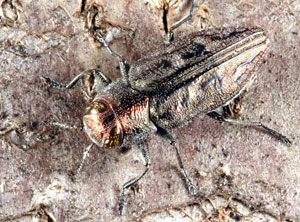
Jim Kalisch, University of Nebraska-Lincoln Dept of Entomology
The Flatheaded apple tree borer is particularly a problem for small, newly planted trees. Larvae are active all summer and feed in the cambium. The feeding damage progresses from the bottom, up the tree, girdling it. Trunks are often deformed and sucker growth may also be seen. As adults they are copper-colored jewel beetles that emerge in May.
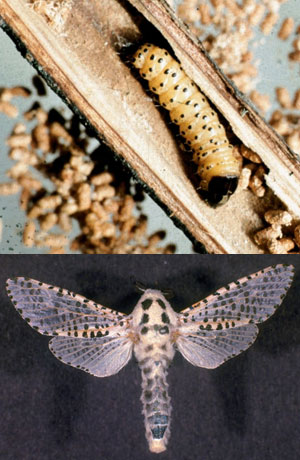
Petr Kapitola, Central Institute for Supervising and Testing in Agriculture,
Bugwood.org (larva);James Solomon, USDA Forest Service, Bugwood.org (adult)
Both the caterpillar and adult of the Wood leopard moth are very distinctive. The caterpillar is the damaging stage, feeding under the bark of host trees. It is a white-orange color with numerous spots on its body. The adult is white with six black dots on the thorax and black markings on the remainder of the body. Adults may be active June-September and larvae feed inside of plants for 2-3 years.
Galls
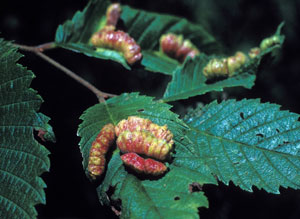
Howard Ensign Evans, Colorado State University, Bugwood.org
Elm cockscomb galls are strangely shaped galls that can appear on slippery elms. The shape early in the season resembles a young green caterpillar but by season's end they resemble the comb found on roosters. The gall houses a female aphid that is asexually producing more aphids inside.